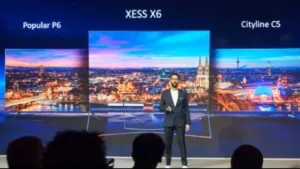TCL held a press event which kicked off 15 minutes late on the day before the show opened. The company used a fine pitch LED behind the presenters to add graphics and show video. Clearly, the sound engineer had a new set of speakers and was determined to show them to the max – it was close to painfully loud!
Anyway, the company used the event to make a global product launch, rather than just a European event. Tomson Li is chairman and CEO of TCL. Unfortunately, he had no sound, at least initially. (and even then, the audio kept swapping from side to side in the stereo mix which made listening trickly!) He said that TCL has increased its exhibition space at IFA.
 Tomson Li of TCL opened the event. Image:Meko
Tomson Li of TCL opened the event. Image:Meko
In 2016, TCL was globally ranked third in the TV market as well as fifth in LCD panels (through its CSOT subsidiary). As well as TVs, the company is in mobile phones and appliances including air conditioning. It has 7,000 R&D personnel and has applied for 13,800 patents.
(TCL provided the following data in its press release:
- In the first quarter of 2017, TCL ranked in top three for global TV shipments, with a market share of 7.3%, according to IHS.
- In the first half of 2017, TCL LCD TV total sales volume rose by 12.2% year-on-year to 9,603,392 sets (excluding commercial display). LCD TV overseas sales volume reached 5.74 million units, up 34.1% year-on-year, while sales value rose 51.0% year-on-year. TCL ranked the third in France and the Philippines, fourth in Thailand and fifth in Vietnam, Australia and the US.)
TCL is an international group and now more than 50% of revenues come from outside China. The company is making a particular effort to boost sales in MEA and Russia as well as the US using the Thomson, Alcatel and Blackberry brands.
Tiago Abreu is a product designer from Portugal. He started by highlighting the 36 years experience of the company and the idea that TV brings people together with good design. Turning to specifics, he looked at the Xess (pronounced “Excess”) sub-brand which is the firm’s premium range and with ‘the most immersive experience’. That means a big screen – for example the 85″ model it has with Quantum Dot technology. TCL is using the QLED name that Samsung has been promoting for its quantum dot-based LCDs. After explaining the concept of QD, Abreu emphasised the long life of the technology.
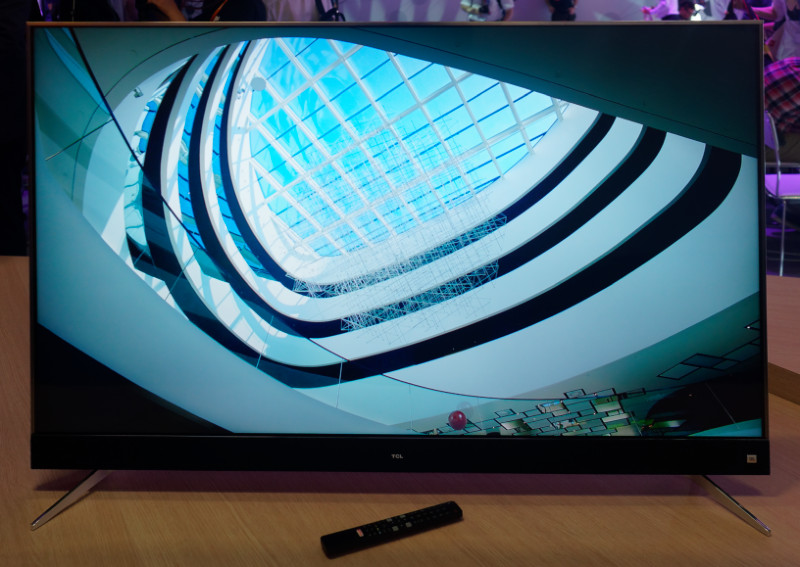 TCL had new designs at the press event. Image:Meko
TCL had new designs at the press event. Image:Meko
TCL supports Dolby Vision and also HDR10 and TCL was the first company in China to achieve Dolby certification. Audio is from Harman/Kardon for sound. The sound system is a 7.1.4 system (the 7 are main drivers, the one is a woofer and the four are the channels of Dolby Atmos). There is a total 320W of audio power in the Xess range.
Design details include a gold decoration on the side of the set. Even the back has been designed to be very clean with a fine fabric that can be used to hide the cable connections.
The mid-range line is the City line – the C5 line that is intended to have a ‘cosmopolitan’ touch. The displays are curved and there is Dolby Vision support and audio from Harman/Kardon, again. One of the features is allowing audio to be played on the sound bar without powering on the display.
The frame has a 9.9mm ultra thin bezel with steel on the top and bottom and aluminium on the sides.
The final model range is the P6 ‘popular’ series for those that are more fashion-conscious. This set is ‘Obsidian black’ colour with a ‘starry night’ fabric on the sound bar, but there are also colour options The P6 is very slim and uses a case manufactured using a single seamless mould. The bezel is 4.8mm wide on the sides and the front power switch can also be used to control the TV if the remote is not available.
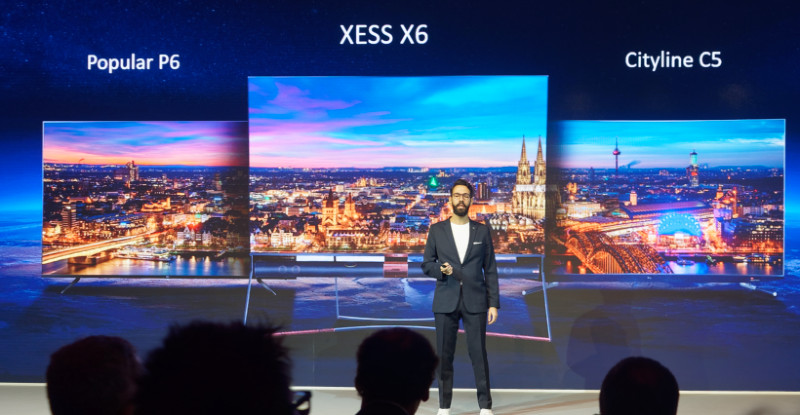 TCL used the event to launch three TV Ranges. Image:Meko
TCL used the event to launch three TV Ranges. Image:Meko
Abreu then switched to discuss AI. TCL believes that its history means it has a very good expertise in understanding the consumer. The remote control is not a very quick way to operate a SmartTV and is not convenient to use so TCL has created a TV that uses AI. Features are:
- Friendly interaction with image recognition and voice control.
- Content aggregation to make it simple to find your content
- Content suggestions and recommendations
- Connectivity is important to allow different devices to talk to each other. The TV can display data from items arond the home
- The system can use AI to identify, for example, actors and use metadata to supply other information
- The AI can also perform similar tasks to Amazon Alexa or Google Connect
Jing Kun is GM of Baidu Duer from China and which develops Baidu’s Duer OS for TVs. The OS exploits Baidu’s search business and experience in natural language processing and can also can support gesture recognition. Kun said that Baidu worked very closely with TCL to integrate the technology into the TVs.
TCL’s P6 series is already on the market in China and others will arrive in the next month. There is an aim to get the products into Europe by Christmas or early in 2018.
The next speaker was Frederic Langin and he is from TCL Europe which started with working on the Thomson brand since 2004 and is now also selling under the TCL brand. The company has facilities in France (R&D and corporate management) and Poland (factory). Exploiting the ‘Silk Road’ facility, the lead time from China to Poland is just 16 days (down from 38 days).
 TCL Europe is exploiting the new ‘Silk Road’ from China to Europe to reduce the shipment time to 16 days to its Polish factory. Image:Meko
TCL Europe is exploiting the new ‘Silk Road’ from China to Europe to reduce the shipment time to 16 days to its Polish factory. Image:Meko
Consumers in Europe are asking for qualities such as size, sound effects, smart TV and design, Langin said.
The C70 series will be launched with a new website, and the company wil be in more stores with the TCL brand in the future and with more dedicated TCL areas in stores. France is the company’s biggest market in Europe and it also has its widest store coverage, so the new marketing will start there. However, the plan is to boost distribution in Denmark, Finland, Germany, Italy, Norway, Poland, Spain and Sweden.
TCL won an award from EISA for the best value TV, the first EISA award for the brand and it has also won a RedDot award in Germany,
The company wants to be the third biggest TV company in Europe (it’s sixth, it says, at the moment) by 2020. This will be done by growing the brand awareness with more marketing activities. For example, the company will be a partner for the Berlin Marathon this year to raise awareness in Germany. The company has started to sell through MediaMarkt and plans to enter the UK & Ireland market as well as a number of countries in Central and Eastern Europe where it currently has little or no presence.
TCL is a member of the QLED Alliance and its European product will have JBL speaker technology. Its TV uses the Android OS.
Booth Tour
There was not a lot of additional information gained from the booth tour that was not discussed in the press conference, but there were a few tidbits to add.
The first thing we noticed when entering the TCL booth was a large center display with QLED in big letters. Clearly, TCL is embracing Samsung’s marketing name for quantum dot-based displays. They even had a big section in one of their brochures devoted to explaining what quantum dots are and their advantages.
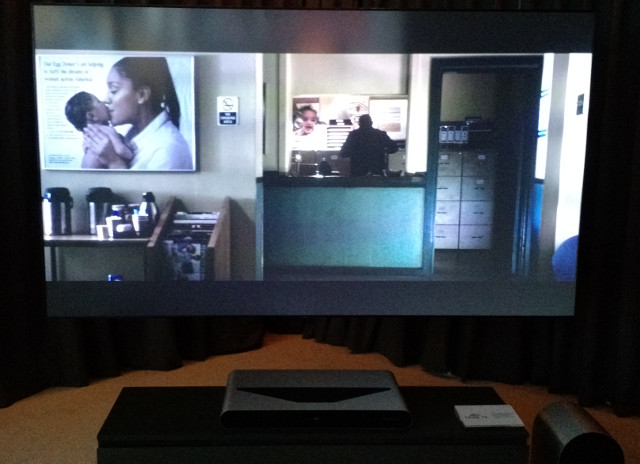
The quantum dot-based Xess line uses a QD film to achieve 99% of the DCI-P3 gamut and 100% color volume. We believe TCL is sourcing these panels from Samsung. The X1 is available in a 65″ screen size (U65S9906) and is a curved model. There are 288 zones in this direct backlight model that can achieve a peak luminance of 1800 cd/m². The X2 is a flat version offered in 65″ (U65X9006) and 55″ (U55X9006) screen sizes. The X2 series uses ultra micro dimming and HDR Pro (both undefined), but apparently with Dolby Vision as well. Peak luminance is cd/m² nits with 16 vertical zones for dimming. The X1 and X2 support HDR10, HLG and 4K HDR from Netflix, and YouTube.
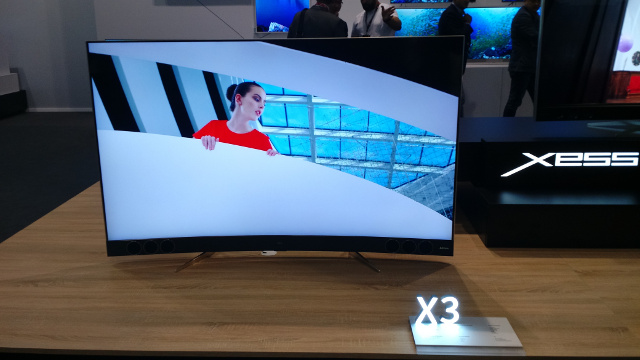 TCL’s X3 is the curved version of the X2
TCL’s X3 is the curved version of the X2
We were also told that that the X3 is the curved version of the X2 series, but has only been released in China so far. Also only in the China market so far is the X6 sometimes called the Private Theater and includes Dolby Atmos as well as Dolby Vision. It is an 85″ quantum dot model with 1200 cd/m² of peak brightness. There are 1206 dimmable zones (with 1206 LEDs) on this one which goes for the equivalent of around 10,000 Euro in China. The X6 uses Harman/Kardon sound while most of the other TCL TVs use JBL sound.
The City Line or C range of UHD TVs have several series. Only the C76 series (49″, 55″ and 65″) and C70 series (49″, 55″, 65″ and 75″) use green and red phosphors added to a blue LED to create a wide color gamut (96% of DCI P3). These are Android-based TVs with around 400 cd/m² of peak luminance. TCL supports HDR10 and HLG plus what they call HDR Pro, but we have no idea what that is! Specific support for Amazon and Netflix HDR is mentioned as well. Support for YouTube HDR will come when the set is upgraded from Android 6.0 to 7.0 (apparently by the user when it is available). The C70 is listed as having “microdimming” but no details were provided.
The C65 series (55″ and 65″) is curved and seems to be the same except for the removal of HDR Pro and wide color gamut capability. The C64 series (43″-65″) is flat and has a slightly lower power audio system than the C76 and no HDR PRO or WCG. The C63 series (43″ to 65″) drops some smart TV features carried in the C64 series.
TCL, like Philips, also uses a metric it calls Picture Performance Index (PPI). TCL says this is the combination of resolution, contrast, color gamut, movement and the type of screen. How these factors are indexed and weighted was not disclosed. The result is a PPI of 1900 for the C70 75″, 1600 for the other C70 sizes, 1500 for the C76 and C65 series and 1200 for the C64 and C63 series. The X1 has a PPI of 2600 while the X2 comes in at 2100.
 TCL’s X1 has a “PPI” of 2600 – the highest image quality shown on the booth
TCL’s X1 has a “PPI” of 2600 – the highest image quality shown on the booth
The P range comes in two series: P60 (43″, 49″, 50″, 55″, 60″ and 65″) and the P600 series (43″, 49″, 50″, 55″, 60″ and 65″). They do not have wide color gamut (coverage not specified and luminance is 300 cd/m². The P60 series has “microdimming”, whatever that means. Both ranges support HDR10 and HLG inputs. Both are edgelit slim designs, but the P60 is listed as an Android TV while the P600 range is called a Smart TV. These should be available for overseas markets in Q4’17.
Finally, there was one demo that said “quantum dot on chip.” We tried to learn more on the show floor, but could not, so have sent emails to try to get some clarification.
 TCL was not explaining what it meant by ‘Quantum dot on chip’
TCL was not explaining what it meant by ‘Quantum dot on chip’
TCL also runs the Alcatel brand for smartphones, but we have reported that separately.
Analyst Comment
I followed up on some of the questions from the tour and got these responses:
I understand that PPI is the combination of resolution, contrast, color gamut, movement and the type of screen. But how are these factors indexed and weighted to get a PPI number
TCL we follow Samsung here by using 100 for each picture technology. We start from 100 for HD standard, then 200 is FHD standard then 400 is basis for UHD and then we add all picture improvement technologies. It is more marketing term and it follows Samsung communication to let sales team match Samsung TVs. We take into account screen resolution, screen shape, motion quality, brightness, contrast, color gamut, dynamic range, 8 or 10bit, anti-reflection coating type, ..
What exactly does the HDR PRO mode do?
TCL HDR Pro in EU range is HDR10 / HLG + 95% DCI-P3. Peak brightness is 400 to 800 nits
The brochure also shows the LED light source as being a blue LED with green and red phosphors without a YAG phosphor. Is this correct?
TCL There are mistakes in the catalogue as it was too late to correct before the show. In 2017 range we use YAG for 709 products, RG phosphor for uv 96% DCI-P3 (C2 range) and QDEF for uv 98% DCI-P3 and 103% color volume (X2 range).
Do the X1, X2, X3 and X6 models support Dolby Vision?
TCL Dolby Vision is supported in China and US, is not supported in EU due to platform differences. X1, X2 is sold in EU, X1, X2, X3, X6 is sold in China.
Tell me more about the quantum dot on chip technology that was mentioned on one of the stands. Is this really red and green QDs on a blue LED?
TCL yes but it is early proto. There was area of prototypes which were decided by HQ. QD on chip was based on early prototype QD on chip diodes. QD Vision had lab run chips in 2016 – days before they were taken over by Samsung. There was also super slim curved LCD based on plastic LGP and 90+ % of rec2020 QD film + super wide gamut color filter tv done as proof of concept by china star.
(CC)
The TCL press event was the first time that I had seen the Baidu voice control system. If the demonstration was really a live demo (and you never really know!), then the technology was impressive and certainly as good or better than the kind of technology that I have seen from specialists such as Tivo. In one sense, then, the event might be an inflection point as this is the first time I remember seeing some software from China that seemed that it might be as good or better than software from the US. (BR)

